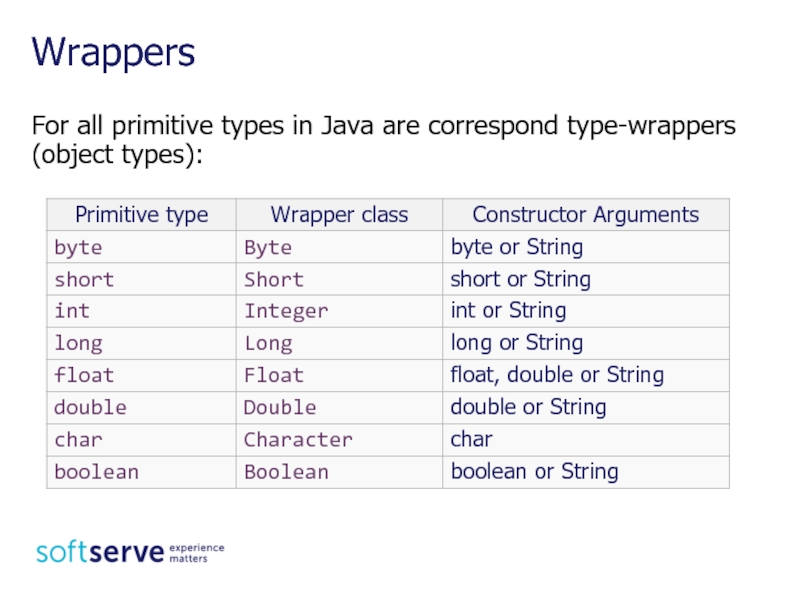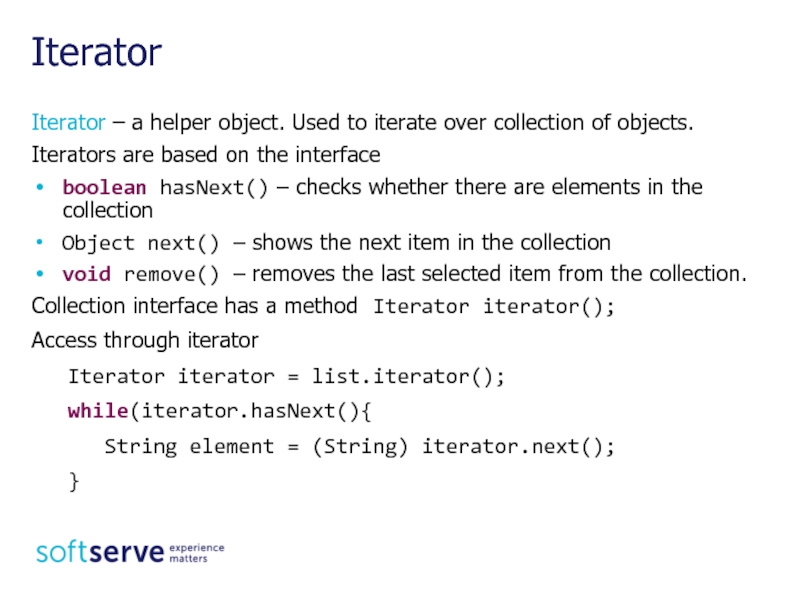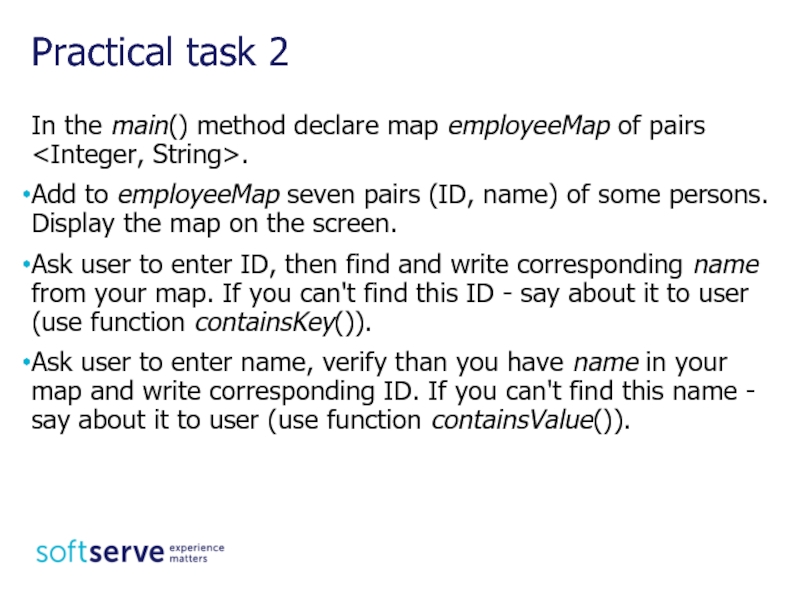- Главная
- Разное
- Дизайн
- Бизнес и предпринимательство
- Аналитика
- Образование
- Развлечения
- Красота и здоровье
- Финансы
- Государство
- Путешествия
- Спорт
- Недвижимость
- Армия
- Графика
- Культурология
- Еда и кулинария
- Лингвистика
- Английский язык
- Астрономия
- Алгебра
- Биология
- География
- Детские презентации
- Информатика
- История
- Литература
- Маркетинг
- Математика
- Медицина
- Менеджмент
- Музыка
- МХК
- Немецкий язык
- ОБЖ
- Обществознание
- Окружающий мир
- Педагогика
- Русский язык
- Технология
- Физика
- Философия
- Химия
- Шаблоны, картинки для презентаций
- Экология
- Экономика
- Юриспруденция
Generic Collections Java Core презентация
Содержание
- 1. Generic Collections Java Core
- 2. Wrapper Pattern Generic in Java Arrays in
- 3. Non-generic Box class public class Box {
- 4. public class Appl { public static
- 5. Wrapper (or Decorator) is one of the
- 6. public class Appl { public static
- 7. Generics, introduced in Java SE 5.0 A
- 8. To update the Box class to use
- 9. public class Box { //
- 10. public class Appl { public static
- 11. Java method can be parametrized, too:
- 12. Disadvantages Generic-fields can not be static. Static
- 13. class Car{ }; // minimal dummy class
- 14. Most efficient way to hold references to
- 15. Collection is a container of Objects, it
- 16. Benefits of collections reduces programming effort increases
- 17. For all primitive types in Java are correspond type-wrappers (object types): Wrappers
- 18. There are data types that represent collections.
- 19. The interface Collection defined methods: boolean
- 20. boolean isEmpty() – returns true, if the
- 21. Interfaces
- 22. List – a list of objects. Objects
- 23. Implementations There are the implementations of the
- 24. List Since List is an interface you
- 25. ArrayList Adding elements List list = new
- 26. Iterator – a helper object. Used to
- 27. ArrayList Removing Elements remove(Object element) remove(int index)
- 28. LinkedList has the same functionality as the
- 29. public static void main (String[ ] args)
- 30. Set A Set is a collection that
- 31. import java.util.*; public class FindDups {
- 32. public class MyList { private
- 33. public static void main(String[] args) {
- 34. import java.util.Arrays; public class Appl {
- 35. To specify the order of the following
- 36. Comparator interface has two methods
- 37. public class Employee { int
- 38. Example 1 import java.util.Comparator; public class NameComparator
- 39. Example 1 import java.util.ArrayList; import java.util.List; public
- 40. public class Employee { int
- 41. static class NameComparator implements Comparator {
- 42. Example 2 public static void main(String[] args)
- 43. Map The most commonly used Map implementations
- 44. Map for (Iterator i = map.entrySet().iterator(); i.hasNext();){
- 45. Practical task 1 Declare collection myCollection of
- 46. Practical task 2 In the main() method
- 47. Homework Write parameterized methods union(Set set1, Set
- 48. Homework Write class Student that provides information
- 49. The end
Слайд 2Wrapper Pattern
Generic in Java
Arrays in Java
Collections in Java
List, Set, Map
Iterators
Methods, sorting
Practical
Agenda
Слайд 3Non-generic Box class
public class Box {
private Object obj;
public void
public Object get( ) { return obj; }
}
Since its methods accept or return an Object, you are free to pass in whatever you want, provided that it is not one of the primitive types.
There is no way to verify, at compile time, how the class is used.
Wrapper Pattern
Слайд 4public class Appl {
public static void main(String[ ] args) {
Box box = new Box();
box.set(text);
Integer i = (Integer) box.get();
}
}
One part of the code may place an Integer in the box and expect to get Integers out of it, while another part of the code may mistakenly pass in a String, resulting in a runtime error.
Wrapper Pattern
Runtime Error
Слайд 5Wrapper (or Decorator) is one of the most important design patterns.
One class takes in another class, both of which extend the same abstract class, and adds functionality.
public class WrapperBox {
private Box box = new Box();
public void set(String text) {
this.box.set(text);
}
public String get( ) { return box.get(); }
}
Wrapper Pattern
Слайд 6public class Appl {
public static void main(String[ ] args) {
WrapperBox box = new WrapperBox();
box.set(text);
Integer i = (Integer) box.get();
}
}
The basic idea of a wrapper is to call-forward to an underlying object, while simultaneously allowing for new code to be executed just before and/or just after the call.
Wrapper Pattern
Слайд 7Generics, introduced in Java SE 5.0
A generic type is a generic
Generics add a way to specify concrete types to general purpose classes and methods that operated on Object before.
With Java's Generics features you can set the type for classes.
Generic class is defined with the following format:
class Name
The type parameter section, delimited by angle brackets (<>), follows the class name.
Generic in Java
Слайд 8To update the Box class to use generics, you create a
public class Box
to
public class Box
This introduces the type variable, T, that can be used anywhere inside the class.
To instantiate this class, use the new keyword, as usual, but place
Box
new Box
Generic in Java
Слайд 9public class Box {
// T stands for "Type".
public void set(T t) { this.t = t; }
public T get( ) { return t; }
}
All occurrences of Object are replaced by T.
A type variable can be any non-primitive type you specify: any class type, any interface type, any array type, or even another type variable.
The same technique can be applied to create generic interfaces.
Generic in Java
Слайд 10public class Appl {
public static void main(String[ ] args) {
Box
box.set(text);
Integer i = (Integer) box.get();
}
}
Generics also provide compile-time type safety that allows programmers to catch invalid types at compile time.
Generic in Java
Слайд 11Java method can be parametrized, too:
getRandomElement(List list) { …
As with class definitions, you often want to restrict the type parameter in the method.
For example, a method which takes a list of Vehicles and returns the fastest vehicle in the list can have the following type.
Generic in Java
Слайд 12Disadvantages
Generic-fields can not be static.
Static methods can not have generic parameters
Can not be made an explicit call to the constructor generic-type:
class Optional
T value = new T();
}
The compiler does not know what constructor can be caused and the amount of memory to be allocated when an object.
Generic in Java
Слайд 13class Car{ }; // minimal dummy class
Car[ ] cars1; // null
Car[ ] cars2 = new Car[10]; // null references
for (int i = 0; i < cars2.length; i++) {
cars2[i] = new Car( );
}
// Aggregated initialization
Car[ ] cars3 = {new Car( ), new Car( ), new Car( )};
cars1 = {new Car( ), new Car( ), new Car( )};
Arrays in Java
Слайд 14Most efficient way to hold references to objects.
Advantages
An array know the
An array knows its size, i.e., ask for the length.
An array can hold primitive types directly.
Disadvantages
An array can only hold one type of objects (including primitives).
Arrays are fixed size.
How to add element inside?
Arrays in Java
Слайд 15Collection is a container of Objects, it groups many Objects into
Collections – dynamic arrays, linked lists, trees, sets, hash tables, stacks, queues.
All collections frameworks contain the following:
interfaces
implementations
algorithms (there are the methods such as searching and sorting)
Collections in Java
Слайд 16Benefits of collections
reduces programming effort
increases program speed and quality
allows interoperability among
reduce effort to design new APIs
helps to reuse the code
Слайд 18There are data types that represent collections.
Classes that implement interfaces List
Interfaces
Слайд 19The interface Collection defined methods:
boolean add(E obj) – adds obj
boolean addAll(Collection c) – adds all the elements;
void clear() – removes all items from the collection;
boolean contains(Object obj) – returns true, if the collection contains an element of obj;
boolean equals(Object obj) – returns true, if the collections are equivalent;
Collections in Java
Слайд 20boolean isEmpty() – returns true, if the collection is empty;
Iterator
boolean remove(Object obj) – removes the object from the collection;
int size() – the number of items in the collection;
Object[] toArray() – copies the collection to an array of objects;
Collections in Java
Слайд 22List – a list of objects. Objects can be added to
Set – a set of objects. The same features as that of the List, but the object can be part of set only once. Double addition of one and the same object in the set is not change the set.
Map – a map or associative array. In Map we add pair of objects (key, value). Accordingly, the search operation is a key value. Adding a couple with an existing key in the Map leads to the replacement, not to upload it. From Map can be obtain key and a list of values.
Collections in Java
Слайд 23Implementations
There are the implementations of the collection interfaces. In essence, they
Слайд 24List
Since List is an interface you need to instantiate a concrete
There are two general-purpose List implementations — ArrayList and LinkedList
For example
java.util.ArrayList
java.util.LinkedList
Here are a few examples of how to create a List instance:
List listArr = new ArrayList();
List listLink = new LinkedList();
Слайд 25ArrayList
Adding elements
List list = new ArrayList();
list.add("First element");
list.add("Second element");
list.add(0, "One more first
Access through index
String element2 = list.get(1);
Access through new for-loop
for(Object object : list) {
String element = (String) object;
}
Слайд 26Iterator – a helper object. Used to iterate over collection of
Iterators are based on the interface
boolean hasNext() – checks whether there are elements in the collection
Object next() – shows the next item in the collection
void remove() – removes the last selected item from the collection.
Collection interface has a method Iterator iterator();
Access through iterator
Iterator iterator = list.iterator();
while(iterator.hasNext(){
String element = (String) iterator.next();
}
Iterator
Слайд 27ArrayList
Removing Elements
remove(Object element)
remove(int index)
Cleaning a list
list.clear();
List size
int size = list.size();
Generic List
List
myType.add(new MyType( ));
MyType my = myType.get(0);
Слайд 28LinkedList has the same functionality as the ArrayList.
Different way of implementation
Adding to the LinkedList is faster
Pass through the list is almost as effective as the ArrayList,
Arbitrary removal from the list is slower than ArrayList.
LinkedList
Слайд 29public static void main (String[ ] args) {
ArrayList cars
for (int i = 0; i < 12; i++) {
cars.add (new Car( ));
}
Iterator it = cars.iterator( );
while (it.hasNext( )) {
System.out.println ((Car)it.next( ));
}
}
Example
Слайд 30Set
A Set is a collection that does not contain any duplicate
Element that are put in a set must override equals() method to establish uniqueness
It is unsorted, unordered Set
Can contain null
Слайд 31import java.util.*;
public class FindDups {
public static void main(String args[
Set s = new HashSet( );
for (int i = 0; i < args.length; i++) {
if (!s.add(args[i]))
System.out.println("Duplicate detected: " +
args[i]);
}
System.out.println(s.size( ) +
" distinct words detected: " + s);
}
}
Example
Слайд 32public class MyList {
private ArrayList v = new ArrayList(
public void add(MyType obj) {
v.add(obj);
}
public MyType get(int index) {
return (MyType)v.get(index);
}
public int size( ) {
return v.size( );
}
}
Wrapper
Collections work with the Object class.
We can add to the collection any objects of Java.
When read from the collection, we also obtain Object.
Add only objects of type MyType for MyList
Слайд 33public static void main(String[] args) {
int[] x =
for (int i = 0; i < x.length; i++) {
Random rand = new Random();
x[i] = rand.nextInt(10);
}
Arrays.sort(x);
for (int i = 0; i < x.length; i++) {
System.out.println(x[i]);
}
}
What is wrong in the code
Write a new code for type double, etc.
Do I need to constantly create "bicycle" ?
You may use an existing solution
Sorting
Слайд 34import java.util.Arrays;
public class Appl {
public static void main(String[ ]
Student[ ] students = new Student[3];
students[0] = new Student(52645, "Oksana");
students[1] = new Student(98765, "Bogdan");
students[2] = new Student(1354, "Orest");
Arrays.sort(students);
for (int i = 0; i < students.length; i++) {
System.out.println(students);
}
}
}
Class Arrays. Sorting
What will happen?
Слайд 35To specify the order of the following interfaces: Comparable and Comparator
String name;
public int compareTo(Object obj) {
return name.compareTo(((MyType)obj).name);
}
}
Comparable to specify only one order.
Method compareTo can return
0, if objects are equal
<0 (-1), if first object is less than second object
>0 (1), if first object is great than second object
Compare elements
Слайд 36Comparator interface has two methods
public int compare(Object o1, Object
// and
public boolean equals(Object obj)
Methods compareTo and compare can throw an exception ClassCastException, if the object types are not compatible in the comparison.
Compare elements
Слайд 37public class Employee {
int tabNumber;
String name;
this.name = name;
this.tabNumber = tabNumber;
}
@Override
public String toString() {
return "Employee [tabNumber=" + tabNumber + ",
name=" + name + "]";
}
}
Example 1
Слайд 38Example 1
import java.util.Comparator;
public class NameComparator implements Comparator{
@Override
public
return o1.name.compareTo(o2.name);
}
}
import java.util.Comparator;
public class TabComparator implements Comparator
@Override
public int compare(Employee o1, Employee o2) {
return o1.tabNumber - o2.tabNumber;
}
}
Слайд 39Example 1
import java.util.ArrayList;
import java.util.List;
public class Main {
public static void
List
list.add(new Employee("Vasya", 15));
list.add(new Employee("Anna", 2));
list.add(new Employee("Alina", 40));
list.sort(new NameComparator());
for (Employee employee : list) {
System.out.println(employee);
}
list.sort(new TabComparator());
for (Employee employee : list) {
System.out.println(employee);
}
}
}
Слайд 40public class Employee {
int tabNumber;
String name;
new NameComparator( );
static TabComparator tabComparator =
new TabComparator();
public static Comparator getNameComparator( ) {
return nameComparator;
}
public static Comparator getTabComparator( ) {
return tabComparator;
}
Example 2
Add get() and set() methods
Слайд 41static class NameComparator implements Comparator {
public int compare(Object o1, Object
return ((Employer)o1).name.compareTo(((Employer)o2).name);
}
}
static class TabComparator implements Comparator {
public int compare(Object o1, Object o2) {
return ((Employer)o1).tabNumber – ((Employer)o2).tabNumber;
}
}
. . .
}
Example 2
Слайд 42Example 2
public static void main(String[] args) {
Set set =
new TreeSet(Employee.getNameComparator());
set.add(new
set.add(new Employee(2, "Anna"));
set.add(new Employee(40, "Alina"));
System.out.println(set);
Set
new TreeSet(Employee.getTabComparator());
set1.addAll(set);
System.out.println(set1);
}
Слайд 43Map
The most commonly used Map implementations are HashMap and TreeMap.
Map mapA
Map mapB = new TreeMap();
Adding elements
mapA.put("key1", "one");
mapA.put("key2", "two");
String value2 = (String) mapA.get("key2");
Removing element
mapA.remove(Object key);
Слайд 44Map
for (Iterator i = map.entrySet().iterator(); i.hasNext();){
Map.Entry entry = (Map.Entry)
System.out.println(entry.getKey() + " "
+ entry.getValue());
}
for (Map.Entry
+ entry.getValue());
}
Слайд 45Practical task 1
Declare collection myCollection of 10 integers and fill it
Find and save in list newCollection all positions of element more than 5 in the collection. Print newCollection
Remove from collection myCollection elements, which are greater then 20. Print result
Insert elements 1, -3, -4 in positions 2, 8, 5. Print result in the format: “position – xxx, value of element – xxx”
Sort and print collection
Use next Collections for this tasks: List, ArrayList, LinkedList
Слайд 46Practical task 2
In the main() method declare map employeeMap of pairs
Add to employeeMap seven pairs (ID, name) of some persons. Display the map on the screen.
Ask user to enter ID, then find and write corresponding name from your map. If you can't find this ID - say about it to user (use function containsKey()).
Ask user to enter name, verify than you have name in your map and write corresponding ID. If you can't find this name - say about it to user (use function containsValue()).
Слайд 47Homework
Write parameterized methods union(Set set1, Set set2) and intersect(Set set1, Set
Create map personMap and add to it ten persons of type
Output the entities of the map on the screen.
There are at less two persons with the same firstName among these 10 people?
Remove from the map person whose firstName is ”Orest” (or other). Print result.
Слайд 48Homework
Write class Student that provides information about the name of the
properties for access to these fields
constructor with parameters
method printStudents (List students, Integer course), which receives a list of students and the course number and prints to the console the names of the students from the list, which are taught in this course (use an iterator)
methods to compare students by name and by course
In the main() method
declare List students and add to the list five different students
display the list of students ordered by name
display the list of students ordered by course.



![public class Appl { public static void main(String[ ] args) { String text =](/img/tmb/4/325852/52412e85e64db4521009be6e0ff3870e-800x.jpg)

![public class Appl { public static void main(String[ ] args) { String text =](/img/tmb/4/325852/d66ab0d9f3678e5ddf74a822b1e2436e-800x.jpg)



![public class Appl { public static void main(String[ ] args) { String text =](/img/tmb/4/325852/f044af0d8b90a930947333dbcc51a57d-800x.jpg)


![class Car{ }; // minimal dummy classCar[ ] cars1; // null referenceCar[ ] cars2 =](/img/tmb/4/325852/7100c060f9314c4955626d94b350bfb9-800x.jpg)















![public static void main (String[ ] args) { ArrayList cars = new ArrayList( ); for](/img/tmb/4/325852/48c64f1d15135e4bdc70dd20adf851a6-800x.jpg)

![import java.util.*;public class FindDups { public static void main(String args[ ]){ Set s =](/img/tmb/4/325852/c88edbae95b24f3fab3bfb7ad1f7713e-800x.jpg)

![public static void main(String[] args) { int[] x = new int[10]; for (int](/img/tmb/4/325852/e3654e2199be51c426f41e8363a59b88-800x.jpg)
![import java.util.Arrays;public class Appl { public static void main(String[ ] args) { Student[ ]](/img/tmb/4/325852/9c34fd5378db86d6bc05d9c2b8c7345f-800x.jpg)




![Example 1import java.util.ArrayList;import java.util.List;public class Main { public static void main(String[] args) { List](/img/tmb/4/325852/c5f06c6e7bafa5768256fadbb7814801-800x.jpg)


![Example 2public static void main(String[] args) {Set set = new TreeSet(Employee.getNameComparator());set.add(new Employee(15,](/img/tmb/4/325852/46ee1f600da529c9a249f96635b64b06-800x.jpg)












